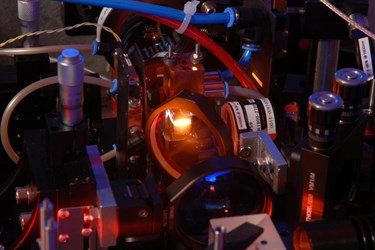National Robotarium to develop made-to-measure 3D laser beams

Researchers at the National Robotarium, hosted by Heriot-Watt University in Edinburgh, have announced that they have secured £586,000 to develop 3D laser beams whose shape can be changed.
These 3D lasers could help to transform the manufacturing and healthcare technology industries, making it easier and more cost effective to produce products that require highly-precise manufacturing, such as medical equipment and mobile devices.
The funding, which has come from the Engineering and Physical Sciences Research Council (EPSRC), part of UK Research and Innovation, will support the research and development of the lasers for industry application, accelerating the commercialisation of the technology for UK manufacturing.
Lasers are a crucial component of modern manufacturing, with the global laser processing market projected to grow from £2.8 billion in 2020 to £4.1 billion by 2025, and are used widely by industry to produce precise incisions and mould materials into specific shapes.
However, this approach to laser-based manufacturing depends on melting or vaporising the material, which means the laser’s energy must be focussed on the right points. The standard laser beam shape makes it difficult to tailor this for specific manufacturing processes, decreasing efficiency and limiting what can be made.
In response, the research to be undertaken at the National Robotarium will develop laser beams which have been specifically designed to meet the exact manufacturing requirements of products, improving efficiency and precision.
The National Robotarium is supported by £21 million from the UK Government and £1.4 million from the Scottish Government as part of the £1.3 billion Edinburgh and South East Scotland City Region Deal – a 15 year investment programme jointly funded by both governments and regional partners.
The new technique could be harnessed to improve how holes for sensors and cameras on smartphone screens are drilled and to increase the density of information on Semiconductor chips, helping to keep up with the ever-increasing demand for more memory in devices.
Medical applications could include cancer surgery, where it is hoped more precise medical instruments could allow the resection of tumours without removing healthy surrounding tissue. In an academic partnership, the project’s research into this kind of medical application will be supported by Professor David Jayne at the University of Leeds.
Other examples include fabricating waveguide devices to support telecommunications and the internet, microscopy and even astronomic telescopes.
The National Robotarium is a leading research facility for robotics and artificial intelligence, and in keeping with its focus on industry collaboration, researchers will be working with three industrial partners throughout the project to optimise the approach and final product for commercial application. Industrial partners PowerPhotonic, Oxford Lasers and the G&H Group will also support testing in real-life industrial settings.
Dr Richard Carter, Assistant Professor of Applied Optics and Photonics at Heriot-Watt University and the project’s lead, said, “Manufacturing is of key strategic importance to the UK, with a particular focus on high-tech and high-value manufacturing. This research will address the priority area of digital manufacturing, enabling a bespoke, rapid response capability for the first time. The new methods we are developing represent a paradigm shift in the capabilities of laser-based manufacturing, making it possible to move between 3D beam shapes with zero down-time, low cost and minimal technical know-how.
“Through collaboration with our industry partners, we’ll be able to develop the lasers in line with what industry needs, providing solutions to manufacturing challenges across a wide range of sectors. However, this technology could also support research in quantum technology, waveguide physics and the bio-sciences – anywhere where light must be controlled and manipulated.”